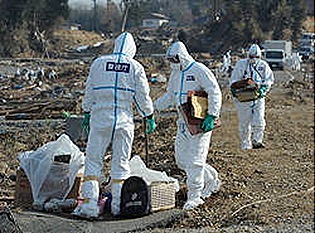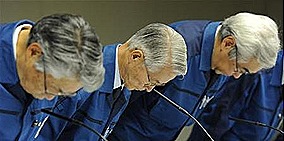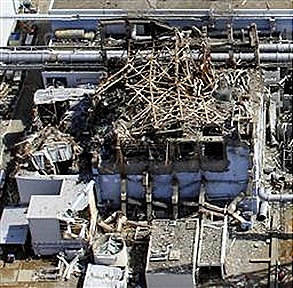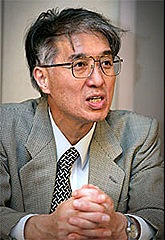This is an article in the Chunichi on April 13. I’ve translated it into English from Japanese of the original one as follows:
The accident level of INES (The International Nuclear Event Scale) at the Fukushima First Nuclear Power Plant of Tokyo Electric Power Company (TEPCO) was raised to 7 from 5 on 12th. It’s the same level of Chernobyl and the worst. There’s a man who is paying close attention to the situation, being frustrated and angry and maybe feeling a sense of defeat. He is Mr. Hiroaki Koide, 61, Associate Professor of Kyoto University Research Reactor Institute. He researches the safety of nuclear reactors and the radioactivity measurement. He has shifted his position of pro-nuke to anti-nuke, and then has publicized the dangers of nuclear power generation for 40 years. This is the interview with him. (by Chiaki Ashihara at Kyoto Branch Office)
The Greatest Fear for the Phreatic Eruption: Incomplete Cooling
“I have many friends who I still can’t contact with in Tohoku area, where I’ve spent my school days and led the movement against nuclear power generation, such as Sendai, Onagawa, and Sanriku.” This is Kyoto University Research Reactor Institute in Kumadori, southern Osaka. There are about 100 cherry trees and the blossoms are wonderful in full bloom in lands, but they put off opening to the public this spring. Rooms are dim. A.Prof. H. Koide began talking, saying, “I don’t want to waste power.”
“The expected worst situation would be meltdown in the accident at Fukusima First Nuclear Plant. It’s clear that the reactor core is melting now, but it’s partial.” The reactor core is the place where uranium of the fuel rod fissions. 93% of caloric value of nuclear is by the atomic fission, but the control rod stopped the reaction after the earthquake. Yet, fission products are settling into the fuel rod and they are remaining as gigantic heating elements. Fission products produce decay heat and the heat can cause meltdown. The decay heat has reduced to a thirtieth after the accident, but it can’t go down so much. It’s the most important to cool the heating reactor core to prevent meltdown. TEPCO and the government have been pouring a large volume of water to the plant. “It’s a tightrope, but it has a cooling effect and has made the possibility of a massive meltdown lower than 50 %. The temperature of the reactor core, however, hasn’t cooled less than 100 ℃ yet. It means cooling is not sufficient. If they couldn’t keep cooling the core, the meltdown would set to be worse.” 
Chernobyl Nuclear Power Plant has also been in meltdown. After the reactor exploded, the remaining core was in meltdown. “It’s possible that the reactor is in meltdown more and more without breaking in Fukushima. If the situation got worse, high temperature dissolved materials would react with water underneath, and which would cause a pheratic explosion, and then incommensurable quantity of radioactive substance would be released. That’s the scariest thing.” The pheratic explosion could be much more massive than ever before. It would destroy the pressure vessel which covers the core and even the outer containment vessel. “If a huge pheratic explosion occurred and most of the radioactive materials in the reactor core were splattered in the air as gas or particulate, the contamination level would be the same as the Chernobyl accident.” In Chernobyl, extreme polluted areas were found 200-300 kilometers away from the nuclear plant three months after the accident. Assuming the same distance from Fukushima, Tokyo metropolitan area also comes within the range. “We couldn’t do anything for it if it happened.”
What about the recriticality? Is it possible to fission again after stopping? According to TEPCO, they are now researching about radioactive materials after the recriticality accident. If the recriticality occurred, its evolution heat and fission products would make the handling much more difficult.
Release the Data
What about the ocean being contaminated by radioactivity? “It’s dangerous to exposure to radiation even in minute amount. I cannot accept the view of the government and experts who say it’s okay and safe to release the polluted water to the ocean because it’ll diffuse. It might cut risk by attenuating but spread contaminated water widely. If they say it’s safe, they should release the exact data to prevent spreading harmful rumors instead of regulating shipping.” According to A. Prof. H. Koide, it’s the most important to check seaweeds which ingest a lot of cesium and iodine to investigate the extent of contamination. Shellfish and fish will show the influence later. “I would examine seaweeds right away. They might already have the data.”
It’s not only the ocean but also the air to have been polluted. The air including radioactive materials has been leaked. The government has told the nation, “It doesn’t have an effect on the human body immediately.” But A. Prof. H. Koide is angry saying, “They should say it doesn’t cause acute radiation damage.” Even small amount of radioactive ingredient could cause late injury such as cancers. Many of survivors of atomic bombings in Hiroshima and Nagasaki have developed leukemia within a few years and then different kinds of cancers ten years later. In Chernobyl, it has been revealed that many children have thyroid’s cancer a few years later.
About the contamination in the air, his co-worker A. Prof. T. Imanaka, 60, and his group investigated in Iidate outside the 30 kilometer-range at the end of last month. The radioactivity level in the place is more than 50 mSV a month, which is the barometer for evacuation set by Nuclear Safety Commission. The research shows the evacuation directive is not sufficient to set areas within 30 km from the nuclear plant. “After researchers investigated the amount of radiation voluntarily, the government released the data of the areas 30 km away from the plant for the first time. Releasing all data would be the most important to prevent panicking, though…”
Why have such dangerous nuclear power plants been advanced so much? A. Prof. H. Koide is pointing out the existence of the industry-government-academia group crowding around money. “For electric power companies, nuclear plants have been golden eggs. They could tack on the expense for power bill and dominate the market. Electric appliance giants and major constructors also have flocked to construction of nuclear plants.” And university researchers have given a stamp of approval to it. “They want research posts and budgets. They need money for studying nuclear. There are many researchers who can’t think of the connection between their specialized field and the society.”
Discrimination against Anti-Nuke Researchers
A. Prof. H. Koide had questions why electric power companies never built nuclear power plants in urban areas when he was a student. He’s experienced the movement against Onagawa Nuclear Power Plant and then has shifted his position of pro-nuke to anti-nuke. He’s worked at Kyoto University for more than 30 years, but he and his co-worker A. Prof. T. Imanaka haven’t promoted yet. “There were many young researchers who emphasized with us so far, but I couldn’t tell them to work together. If they threw in us, they couldn’t live as researchers in stable condition. But I regret that. I’m afraid that researchers who publicly disagree with nuclear power generation might not appear any more after Iamanaka and I were gone.”
The power of money and the government’s policy for promoting nuclear power plants has been enormous. But Japan is the only country to have ever experienced nuclear devastation and has strong nuclear allergy. Why has the country advanced building nuclear power plants? “It’s because Japan would rather maintain its manufacturing power than have nuclear weapons themselves. If they promote nuclear power plants, they’ll get the technology and the ingredient, plutonium.” He emphasizes the importance of stopping all of the nuclear power plants immediately. “The accident this time is now going on and no one knows how the damage will extend. We wouldn’t be able to make it up if we used all money the nuclear power plants had made. Nuclear power plants are unreasonable.”
Hiroaki Koide
Born in Tokyo, 1949. Graduated from Tohoku University (Nuclear Engineering Department), Associated professor in Kyoto University Research Reactor Institute. The deponent for citizens of the lawsuit over Ikata Nuclear Power Plant


